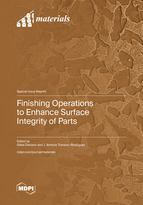Finishing Operations to Enhance Surface Integrity of Parts
A special issue of Materials (ISSN 1996-1944). This special issue belongs to the section "Manufacturing Processes and Systems".
Deadline for manuscript submissions: closed (20 November 2022) | Viewed by 17645
Special Issue Editors
Interests: manufacturing; materials science; burnishing; surface integrity
Interests: manufacturing; burnishing; surface integrity; additive manufacturing
Special Issues, Collections and Topics in MDPI journals
Special Issue Information
Dear Colleagues,
Surface integrity management is remarkably important when metal alloys are used to manufacture relevant parts. Advanced materials such as titanium, nickel alloys, non-ferrous alloys, or special steels make surface integrity preservation after machining particularly difficult. Consequently, thorough finishing techniques are required to rectify the surface integrity.
Engineering surfaces that exemplify the importance of surface integrity control are typically found in the transportation industry. Pieces formed by complex curved surfaces, such as turbine blades or landing gears, and molds and dies for upsetting operations, are good examples. These kinds of parts are often manufactured through 3 or 5 axis machining with the aid of successive adjacent passes of hemispherical tools, whereas this ball-end milling strategy allows one to achieve complex surfaces by following the desired shape through NC interpolations generated by a CAM (it also has deep constraints).
In this context, processes like burnishing, honing, plateau-honing, grinding, and shot peening can contribute to improving the described surfaces in terms of texture, residual stress, and hardness, as well as for being easily maneuverable from a procedural point of view. This Special Issue is proposed to collect the research results about these kinds of finishing processes, which are very important to the transportation industry.
It is our pleasure to invite you to submit a manuscript for this Special Issue. Full papers, communications, and reviews are all welcome.
Prof. Dr. Gilles Dessein
Dr. J. Antonio Travieso-Rodriguez
Guest Editors
Manuscript Submission Information
Manuscripts should be submitted online at www.mdpi.com by registering and logging in to this website. Once you are registered, click here to go to the submission form. Manuscripts can be submitted until the deadline. All submissions that pass pre-check are peer-reviewed. Accepted papers will be published continuously in the journal (as soon as accepted) and will be listed together on the special issue website. Research articles, review articles as well as short communications are invited. For planned papers, a title and short abstract (about 100 words) can be sent to the Editorial Office for announcement on this website.
Submitted manuscripts should not have been published previously, nor be under consideration for publication elsewhere (except conference proceedings papers). All manuscripts are thoroughly refereed through a single-blind peer-review process. A guide for authors and other relevant information for submission of manuscripts is available on the Instructions for Authors page. Materials is an international peer-reviewed open access semimonthly journal published by MDPI.
Please visit the Instructions for Authors page before submitting a manuscript. The Article Processing Charge (APC) for publication in this open access journal is 2600 CHF (Swiss Francs). Submitted papers should be well formatted and use good English. Authors may use MDPI's English editing service prior to publication or during author revisions.
Keywords
- Finishing
- Burnishing
- Honing
- Grinding
- Shot peening
- Surface integrity
- Roughness








